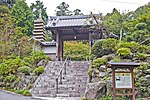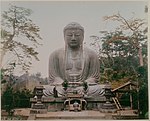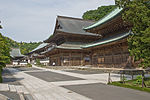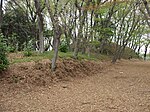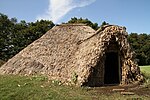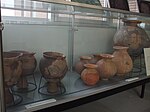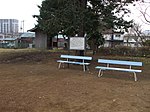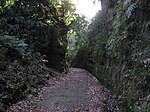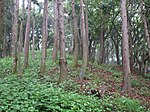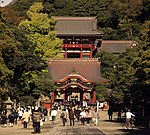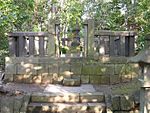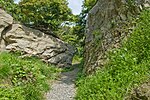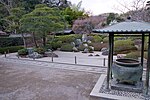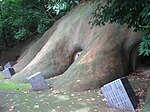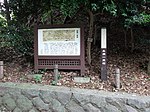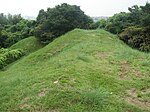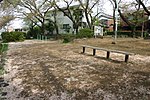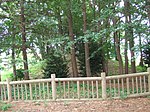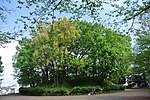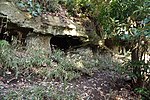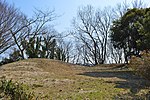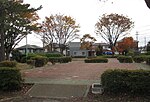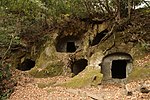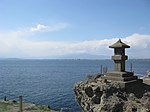Site
Municipality
Comments
Image
Coordinates
Type
Ref.
Isehara Hachimandai Stone Age Dwelling Site 伊勢原八幡台石器時代住居跡 Isehara Hachimandai sekki-jidai jūkyo ato
Isehara
Jomon period settlement trace
35°23′20″N 139°18′31″E / 35.38893842°N 139.30849847°E / 35.38893842; 139.30849847 (Isehara Hachimandai Stone Age Dwelling Site )
1
792
Isshōmasu Site 一升桝遺跡 Isshōmasu iseki
Kamakura
Kamakura period earthworks beside the road, half a kilometre from
Gokuraku-ji
[5]
35°18′53″N 139°31′39″E / 35.3146051°N 139.52758283°E / 35.3146051; 139.52758283 (Isshōmasu Site )
2, 6
00003514
Inamuragasaki 稲村ヶ崎 (新田義貞徒渉伝説地) Inamuragasaki
Kamakura
Kamakura period site where
Nitta Yoshisada entered Kamakura during the
Siege of Kamakura (1333)
Inamuragasaki
35°18′07″N 139°31′32″E / 35.30199813°N 139.52549508°E / 35.30199813; 139.52549508 (Inamuragasaki )
8
790
Egara Tenjin Shrine Precinct 荏柄天神社境内 Egara Tenjin-sha keidai
Kamakura
Shinto shrine submitted for inscription on the UNESCO World Heritage List as one of the
Temples, Shrines and other structures of Ancient Kamakura ;
[6]
[7] the
ICP
honden dates to 1316
[8]
Egara Tenjin Shrine Precinct
35°19′33″N 139°33′52″E / 35.32592137°N 139.56436886°E / 35.32592137; 139.56436886 (Egara Tenjin Shrine Precinct )
3
00003454
Yōfuku-ji ruins 永福寺跡 Yōfukuji ato
Kamakura
Buddhist temple ruins submitted for inscription on the UNESCO World Heritage List as one of the
Temples, Shrines and other structures of Ancient Kamakura
[6]
[7]
Yōfukuji ruins
35°19′38″N 139°34′08″E / 35.32731805°N 139.56881901°E / 35.32731805; 139.56881901 (Yōfukuji ruins )
3
804
Engaku-ji Precinct 円覚寺境内 Engakuji keidai
Kamakura
Buddhist temple submitted for inscription on the UNESCO World Heritage List as one of the
Temples, Shrines and other structures of Ancient Kamakura
[6]
[7]
Engakuji Precinct
35°20′16″N 139°32′52″E / 35.33790762°N 139.5478108°E / 35.33790762; 139.5478108 (Engakuji Precinct )
3
808
Engaku-ji Gardens 円覚寺庭園 Engakuji teien
Kamakura
Buddhist temple garden; also a
Place of Scenic Beauty ; submitted for inscription on the UNESCO World Heritage List as one of the
Temples, Shrines and other structures of Ancient Kamakura
[6]
[7]
Engakuji Gardens
35°20′12″N 139°32′43″E / 35.33677183°N 139.54539308°E / 35.33677183; 139.54539308 (Engakuji Gardens )
8
788
Shimoterao Kanga site 下寺尾官衙遺跡群 Shimoterao kanga iseki-gun
Chigasaki
Nara / Heian period local administration complex ruins
35°21′46″N 139°23′48″E / 35.362666°N 139.396538°E / 35.362666; 139.396538 (Shimoterao Kanga ruins )
2
00003890
Kewaizaka Pass 仮粧坂 Kehaizaka
Kamakura
Kamakura period sites submitted for inscription on the UNESCO World Heritage List as one of the
Temples, Shrines and other structures of Ancient Kamakura
[6]
[7]
Kewaizaka Pass
35°19′37″N 139°32′44″E / 35.32695051°N 139.54566391°E / 35.32695051; 139.54566391 (Kewaizaka Pass )
6
814
Natsushima Shell Mound
夏島貝塚 Natsushima kaizuka
Yokosuka
Jomon period shell midden
35°19′21″N 139°38′58″E / 35.32236445°N 139.64956105°E / 35.32236445; 139.64956105 (Natsushima Shell Mound )
1
817
Kakuon-ji Precinct
覚園寺 境内 Kakuonji keidai
Kamakura
Buddhist temple submitted for inscription on the UNESCO World Heritage List as one of the
Temples, Shrines and other structures of Ancient Kamakura
[6]
[7]
Kakuonji Precinct
35°19′59″N 139°33′49″E / 35.33298577°N 139.56353313°E / 35.33298577; 139.56353313 (Kakuonji Precinct )
3
809
Kamakura Daibutsuden 鎌倉大仏殿跡 Kamakura daibutsuden ato
Kamakura
Buddhist temple submitted for inscription on the UNESCO World Heritage List as one of the
Temples, Shrines and other structures of Ancient Kamakura
[6]
[7]
Kamakura Daibutsuden ruins
35°19′00″N 139°32′09″E / 35.31673435°N 139.53571041°E / 35.31673435; 139.53571041 (Kamakura Daibutsuden ruins )
3
3385
Kamegayatsuzaka Pass 亀ヶ谷坂 Kamegayatsuzaka
Kamakura
Kamakura period site submitted for inscription on the UNESCO World Heritage List as one of the
Temples, Shrines and other structures of Ancient Kamakura
[6]
[7]
Kamegayatsuzaka Pass
35°19′51″N 139°33′01″E / 35.33076405°N 139.55038805°E / 35.33076405; 139.55038805 (Kamegayatsuzaka Pass )
6
812
Tachibana Kanga site 橘樹官衙遺跡群 Tachibana kanga iseki-gun
Kawasaki
Nara / Heian period local administration complex ruins
Tachibana Kanga ruins
35°34′42″N 139°37′09″E / 35.578452°N 139.619204°E / 35.578452; 139.619204 (Tachibana Kanga ruins )
2
00003889
Former
Yokohama Specie Bank Head Office 旧横浜正金銀行本店 kyū-Yokohama Shōkin Ginkō honten kaizuka
Yokohama
established in 1880, the
ICP honkan (main building) dates to 1904 and is used for the
Kanagawa Prefectural Museum of Cultural History
[9]
Former Yokohama Specie Bank Head Office
35°26′57″N 139°38′11″E / 35.449059°N 139.636307°E / 35.449059; 139.636307 (Former Yokohama Specie Bank Head Office )
6
824
Sagami River Bridge ruins
旧相模川橋脚 kyū-Sagami-gawa kyōkyaku
Chigasaki
also a
Natural Monument
Sagami River Bridge ruins
35°19′55″N 139°23′04″E / 35.33198299°N 139.38441004°E / 35.33198299; 139.38441004 (Sagami River Bridge ruins )
6
777
Kobukurozaka Pass 巨福呂坂 Kobukurozaka
Kamakura
Kamakura period
Kobukurozaka Pass
35°19′39″N 139°33′16″E / 35.32739418°N 139.55455648°E / 35.32739418; 139.55455648 (Kobukurozaka Pass )
6
813
Gokuraku-ji Precinct - Tomb of
Ninshō 極楽寺境内・忍性墓 Gokurakuji keidai・Ninshō no haka
Kamakura
Buddhist temple submitted for inscription on the UNESCO World Heritage List as one of the
Temples, Shrines and other structures of Ancient Kamakura
[6]
[7]
Gokurakuji Precinct - Tomb of Ninshō
35°18′36″N 139°31′44″E / 35.3100966°N 139.52880202°E / 35.3100966; 139.52880202 (Gokurakuji Precinct - Tomb of Ninshō )
7
781
Kenchō-ji Precinct 建長寺境内 Kenchōji keidai
Kamakura
Buddhist temple submitted for inscription on the UNESCO World Heritage List as one of the
Temples, Shrines and other structures of Ancient Kamakura
[6]
[7]
Kenchōji Precinct
35°19′54″N 139°33′17″E / 35.33160435°N 139.55467388°E / 35.33160435; 139.55467388 (Kenchōji Precinct )
3
805
Kenchō-ji Gardens 建長寺庭園 Kenchōji teien
Kamakura
Buddhist temple gardens; also a
Place of Scenic Beauty ; submitted for inscription on the UNESCO World Heritage List as one of the
Temples, Shrines and other structures of Ancient Kamakura
[6]
[7]
Kenchōji Gardens
35°19′56″N 139°33′20″E / 35.33218681°N 139.55554868°E / 35.33218681; 139.55554868 (Kenchōji Gardens )
8
787
Moto-Hakone Stone Buddhas 元箱根石仏群 Moto-Hakone sekibutsu
Hakone
Kamakura period monuments; designation includes three
gorintō , one dating to 1295, and a
hōkyōintō of 1296; the
ICP sculptures date from the late C13/early C14
[10]
[11]
[12]
Moto-Hakone Stone Buddhas
35°13′02″N 139°02′19″E / 35.21714185°N 139.03863773°E / 35.21714185; 139.03863773 (Moto-Hakone Stone Buddhas )
3
797
Goryōgaidai Shell Mound 五領ヶ台貝塚 Goryōgaidai kaizuka
Hiratsuka
Jomon period shell midden
35°21′16″N 139°18′02″E / 35.35437008°N 139.300568°E / 35.35437008; 139.300568 (Goryōgaidai Shell Mound )
1
818
Grave of
William Adams 三浦安針墓 Miura Anjin no haka
Yokosuka
Edo Period personage
Grave of William Adams
35°16′45″N 139°38′27″E / 35.27911496°N 139.64084299°E / 35.27911496; 139.64084299 (Grave of William Adams )
7
774
Santonodai Site
三殿台遺跡 Santonodai iseki
Yokohama
Yayoi period settlement trace
Santonodai Site
35°25′14″N 139°36′39″E / 35.42065195°N 139.61075656°E / 35.42065195; 139.61075656 (Santonodai Site )
1
802
Wakamiya Ōji 若宮大路 Wakamiya Ōji
Kamakura
Kamakura period site submitted for inscription on the UNESCO World Heritage List as one of the
Temples, Shrines and other structures of Ancient Kamakura
[6]
[7]
Wakamiya Ōji
35°18′58″N 139°33′01″E / 35.31612247°N 139.55027298°E / 35.31612247; 139.55027298 (Wakamiya Ōji )
3, 6
793
Jufuku-ji Precinct 寿福寺境内 Jufukuji keidai
Kamakura
Buddhist temple submitted for inscription on the UNESCO World Heritage List as one of the
Temples, Shrines and other structures of Ancient Kamakura
[6]
[7]
Jufukuji Precinct
35°19′27″N 139°32′57″E / 35.32417515°N 139.54924252°E / 35.32417515; 139.54924252 (Jufukuji Precinct )
3
801
Akibayama Kofun Cluster
秋葉山古墳群 Akibayama kofun-gun
Ebina
Konfun period tumuli
Akibayama Kofun Cluster
35°28′12″N 139°24′15″E / 35.47004387°N 139.4041932°E / 35.47004387; 139.4041932 (Akibayama Kofun Cluster )
1
00003453
Katsusaka Site
勝坂遺跡 Katsusaka iseki
Sagamihara
Jomon period settlement trace
Katsusaka Site
35°30′32″N 139°23′18″E / 35.50889722°N 139.38826591°E / 35.50889722; 139.38826591 (Katsusaka Site )
1
819
Odawara Castle ruins 小田原城跡 Odawara-jō ato
Odawara
Sengoku / Edo period castle
Odawara Castle ruins
35°15′03″N 139°09′13″E / 35.25069544°N 139.1535599°E / 35.25069544; 139.1535599 (Odawara Castle ruins )
2
794
Shōmyō-ji Precinct
称名寺 境内 Shōmyōji keidai
Yokohama
Buddhist temple submitted for inscription on the UNESCO World Heritage List as one of the
Temples, Shrines and other structures of Ancient Kamakura
[6]
[7]
Shōmyōji Precinct
35°20′38″N 139°37′49″E / 35.34401438°N 139.63033998°E / 35.34401438; 139.63033998 (Shōmyōji Precinct )
3
773
Jōkōmyō-ji Precinct - Grave of
Reizei Tamesuke
浄光明寺 境内・
冷泉為相 墓 Jōkōmyōji keidai・Reizei Tamesuke haka
Kamakura
Buddhist temple submitted for inscription on the UNESCO World Heritage List as one of the
Temples, Shrines and other structures of Ancient Kamakura
[6]
[7]
Jōkōmyōji Precinct
35°19′37″N 139°33′05″E / 35.32698816°N 139.55137061°E / 35.32698816; 139.55137061 (Jōkōmyōji Precinct )
3, 7
780
Jōchi-ji Precinct 浄智寺境内 Jōchiji keidai
Kamakura
Buddhist temple founded in Kamakura period
Jōchiji Precinct
35°20′00″N 139°32′48″E / 35.33345466°N 139.54661145°E / 35.33345466; 139.54661145 (Jōchiji Precinct )
3
800
Jōmyō-ji Precinct 浄妙寺境内 Jōmyōji keidai
Kamakura
Buddhist temple founded in Kamakura period
Jōmyōji Precinct
35°19′21″N 139°34′16″E / 35.32257345°N 139.57111023°E / 35.32257345; 139.57111023 (Jōmyōji Precinct )
3
806
Kanzaki Site
神崎遺跡 Kanzaki iseki
Ayase
Yayoi period settlement trace
Kanzaki Site
35°24′37″N 139°24′26″E / 35.41024387°N 139.40715118°E / 35.41024387; 139.40715118 (Kanzaki Site )
1
00003699
Zuisen-ji Precinct 瑞泉寺境内 Zuisenji keidai
Kamakura
Buddhist temple, submitted for inscription on the UNESCO World Heritage List as one of the
Temples, Shrines and other structures of Ancient Kamakura
[6]
[7]
Zuisenji Precinct
35°19′21″N 139°34′16″E / 35.32257345°N 139.57111023°E / 35.32257345; 139.57111023 (Zuisenji Precinct )
3
815
Suara Stone Age Site
寸沢嵐石器時代遺跡 Suara shisekki-jidai iseki
Sagamihara
Jomon period settlement trace
Suara Stone Age Site
35°36′00″N 139°13′24″E / 35.59995902°N 139.22343084°E / 35.59995902; 139.22343084 (Suara Stone Age Site )
1
785
Mount Ishigaki
石垣山 Ishigaki-yama
Odawara
site of Sengoku period
Ishigakiyama Ichiya Castle
Mount Ishigaki
35°14′08″N 139°07′39″E / 35.23545028°N 139.12745228°E / 35.23545028; 139.12745228 (Mount Ishigaki )
2
799
Kawajiri Stone Age Site
川尻石器時代遺跡 Kawajiri shisekki-jidai iseki
Sagamihara
Jomon period settlement trace
35°35′30″N 139°18′01″E / 35.5915723°N 139.30018766°E / 35.5915723; 139.30018766 (Kawajiri Stone Age Site )
1
786
Sagami Kokubun-ji ruins
相模国分寺 跡 Sagami Kokubunji ato
Ebina
Nara period
provincial temple of
Sagami Province
Sagami Kokubunji ruins
35°27′16″N 139°23′52″E / 35.45443278°N 139.39780691°E / 35.45443278; 139.39780691 (Sagami Kokubunji ruins )
3
771
Sagami Kokubun-niji ruins
相模国分尼寺 跡 Sagami Kokubunniji ato
Ebina
Nara period
provincial nunnery of
Sagami Province
Sagami Kokubunniji ruins
35°27′38″N 139°23′53″E / 35.46047584°N 139.39806854°E / 35.46047584; 139.39806854 (Sagami Kokubunniji ruins )
3
825
Ōmachi Shakadō Pass Site 大町釈迦堂口遺跡 Ōmachi Shakado-guchi iseki
Kamakura
Kamakura period
Ōmachi Shakadō Pass Site
35°19′02″N 139°33′54″E / 35.31725805°N 139.56498735°E / 35.31725805; 139.56498735 (Ōmachi Shakadō Pass Site )
3
00003681
Ōtsuka-Saikachido Site
大塚・歳勝土遺跡 Ōtsuka-Saikachido iseki
Yokohama
Yayoi period settlement trace
Ōtsuka-Saikachido Site
35°33′02″N 139°34′50″E / 35.55066428°N 139.58062308°E / 35.55066428; 139.58062308 (Ōtsuka-Saikachido Site )
1
823
Daibutsu Pass 大仏切通 Daibutsu kiridōshi
Kamakura
Kamakura period site submitted for inscription on the UNESCO World Heritage List as one of the
Temples, Shrines and other structures of Ancient Kamakura
[6]
[7]
Daibutsu Pass
35°19′38″N 139°31′59″E / 35.32709408°N 139.53318115°E / 35.32709408; 139.53318115 (Daibutsu Pass )
6
820
Asaina Pass 朝夷奈切通 Asaina kiridōshi
Kamakura
Kamakura period site submitted for inscription on the UNESCO World Heritage List as one of the
Temples, Shrines and other structures of Ancient Kamakura
[6]
[7]
Asaina Pass
35°19′51″N 139°35′28″E / 35.33076405°N 139.59105875°E / 35.33076405; 139.59105875 (Asaina Pass )
6
811
Nagae-Sakurayama Kofun Cluster
長柄桜山古墳群 Nagae-Sakurayama kofun-gun
Zushi ,
Hayama
Kofun period tumuli cluster
Nagae-Sakurayama Kofun Cluster
35°17′14″N 139°35′05″E / 35.28711559°N 139.58482271°E / 35.28711559; 139.58482271 (Nagae-Sakurayama Kofun Cluster )
1
3351
Tsurugaoka Hachiman-gū Precinct 鶴岡八幡宮境内 Tsurugaoka Hachimangū keidai
Kamakura
Shinto shrine submitted for inscription on the UNESCO World Heritage List as one of the
Temples, Shrines and other structures of Ancient Kamakura
[6]
[7]
Tsurugaoka Hachimangū Precinct
35°19′31″N 139°33′21″E / 35.32529159°N 139.5559293°E / 35.32529159; 139.5559293 (Tsurugaoka Hachimangū Precinct )
3
807
Grave of
Uesugi Norikata 伝
上杉憲方 墓 den-Uesugi Norikata no haka
Kamakura
Kamakura period tomb
35°18′34″N 139°31′47″E / 35.30952262°N 139.52962639°E / 35.30952262; 139.52962639 (Grave of Uesugi Norikata )
7
782
Tanamukaihara Site
田名向原遺跡 Tanamukaihara iseki
Sagamihara
Japanese Paleolithic Site
35°31′46″N 139°21′18″E / 35.52930989°N 139.35507767°E / 35.52930989; 139.35507767 (Tanamukaihara Site )
1
3244
Tōshō-ji Site 東勝寺跡 Tōshōji ato
Kamakura
Buddhist temple ruins submitted for inscription on the UNESCO World Heritage List as one of the
Temples, Shrines and other structures of Ancient Kamakura
[6]
[7]
Tōshōji Site
35°19′14″N 139°33′35″E / 35.32065359°N 139.55969649°E / 35.32065359; 139.55969649 (Tōshōji Site )
2, 3
3213
Fujisawa Memorial Tower to Friends and Foe 藤沢敵御方供養塔 Fujisawa tekimikata kuyōtō
Fujisawa
Sengoku period monument erected to commemorate those who fell in the
Uesugi Zenshū Rebellion (
上杉禅秀の乱 of
Ōei 23 (1416); on the grounds of
Shōjōkō-ji (
清浄光寺
[13]
Fujisawa Memorial Tower to Friends and Foe
35°20′51″N 139°29′19″E / 35.34760627°N 139.48867362°E / 35.34760627; 139.48867362 (Fujisawa Memorial Tower to Friends and Foe )
3
776
Grave of
Hino Toshimoto
日野俊基 墓 Hino Toshimoto no haka
Kamakura
Kamakura period
Grave of Hino Toshimoto
35°19′41″N 139°32′35″E / 35.32816406°N 139.54303228°E / 35.32816406; 139.54303228 (Grave of Hino Toshimoto )
7
779
Hakone Barrier Site
箱根関 跡 Hakone no seki ato
Hakone
Edo Period
Hakone Barrier Site
35°11′33″N 139°01′34″E / 35.1923674°N 139.02617866°E / 35.1923674; 139.02617866 (Hakone Barrier Site )
6
772
Buppō-ji Site 仏法寺跡 Buppōji ato
Kamakura
Buddhist temple submitted for inscription on the UNESCO World Heritage List as one of the
Temples, Shrines and other structures of Ancient Kamakura
[6]
[7]
35°18′26″N 139°31′52″E / 35.30735767°N 139.53098513°E / 35.30735767; 139.53098513 (Buppōji Site )
3
00003501
Hokkedō Site 法華堂跡 (源頼朝墓・北条義時墓) Hokkedō ato (Minamoto Yoritomo no haka・Hōjō Yoshitoki no haka)
Kamakura
designation includes the
tomb of Minamoto no Yoritomo and the tomb of
Hōjō Yoshitoki
Hokkedō Site
35°19′33″N 139°33′40″E / 35.32591733°N 139.56099667°E / 35.32591733; 139.56099667 (Hokkedō Site )
3, 7
778
Hōjō Clan
Tokiwa Residence Site
北条氏常盤亭跡 Hōjō-shi Tokiwa-tei ato
Kamakura
submitted for inscription on the UNESCO World Heritage List as one of the
Temples, Shrines and other structures of Ancient Kamakura
[6]
[7]
35°19′24″N 139°31′55″E / 35.32340499°N 139.53200341°E / 35.32340499; 139.53200341 (Hōjō Clan Tokiwa Residence Site )
2
821
Nagoe Pass 名越切通 Nagoe kiridōshi
Kamakura
Kamakura period site submitted for inscription on the UNESCO World Heritage List as one of the
Temples, Shrines and other structures of Ancient Kamakura
[6]
[7]
Nagoe Pass
35°18′27″N 139°33′53″E / 35.30738381°N 139.56470343°E / 35.30738381; 139.56470343 (Nagoe Pass )
6
803
Meigetsu-in Precinct 明月院境内 Meigetsuin keidai
Kamakura
Buddhist temple
Meigetsuin Precinct
35°20′06″N 139°33′05″E / 35.33504347°N 139.55130101°E / 35.33504347; 139.55130101 (Meigetsuin Precinct )
3
822
Wakae Island 和賀江嶋 Wakaejima
Kamakura ,
Zushi
Kamakura period site submitted for inscription on the UNESCO World Heritage List as one of the
Temples, Shrines and other structures of Ancient Kamakura
[6]
[7]
Wakae Island
35°18′01″N 139°33′05″E / 35.30028254°N 139.55142955°E / 35.30028254; 139.55142955 (Wakae Island )
3, 5, 6
810
Akasaka Site 赤坂遺跡 Akasaka iseki
Miura
Yayoi period settlement trace
Akasaka Site
35°10′28″N 139°38′03″E / 35.174421°N 139.634081°E / 35.174421; 139.634081 (Akasaka Site )
1
00003779
Old Hakone Road
箱根旧街道 Hakone kyū-kaidō
Hakone
stretch of the old
Tōkaidō ; the designation includes areas of
Mishima and
Kannami in
Shizuoka Prefecture
Old Hakone Road
35°11′36″N 139°01′35″E / 35.19331254°N 139.02647902°E / 35.19331254; 139.02647902 (Old Hakone Road )
6
798
Tokyo Bay Fortress Sites
東京湾要塞 跡 Tōkyō-wan yōsai ato
Yokosuka
designation includes the sites of
Sarushima Battery (猿島砲台跡 and Chiyogasaki Battery (千代ヶ崎砲台跡
35°17′10″N 139°41′38″E / 35.286020°N 139.693995°E / 35.286020; 139.693995 (Tokyo Bay Fortress )
2
00003891
Stone Quarries for Edo Castle Site 江戸城石垣石丁場跡 Edo-jō ishigaki ishi-chōba ato
Odawara
designation includes areas of
Atami and
Itō in
Shizuoka Prefecture
35°14′08″N 139°07′40″E / 35.235421°N 139.127692°E / 35.235421; 139.127692 (Stone Quarries for Edo Castle )
6
00003930
Shimoterao Nishikata Site 下寺尾西方遺跡 Shimoterao Nishikata iseki
Chigasaki
Yayoi period settlement trace
35°21′49″N 139°24′01″E / 35.363607°N 139.400166°E / 35.363607; 139.400166 (Shimoterao Nishikata Site )
1
00003890






